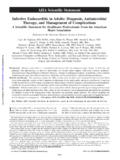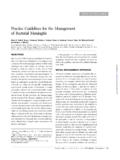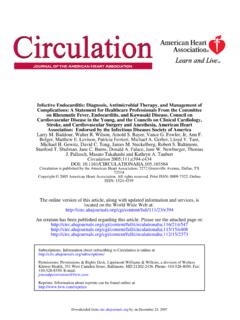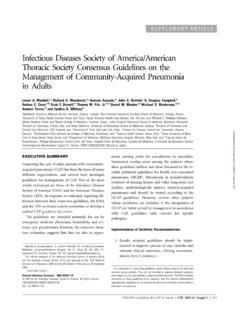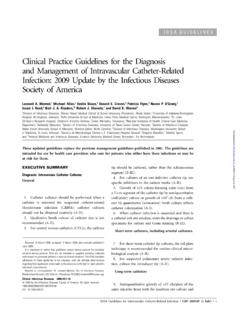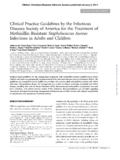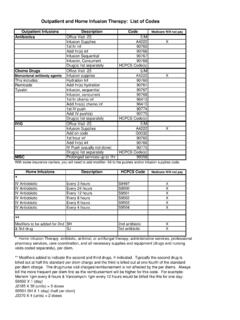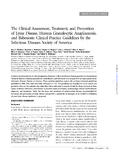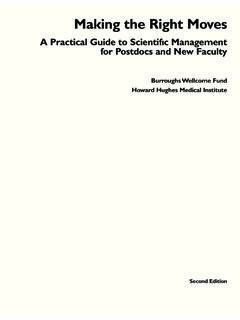Transcription of AHA Scientific Statement - IDSA
1 ISSN: 1524-4539 Copyright 2005 American Heart Association. All rights reserved. Print ISSN: 0009-7322. Online72514 Circulation is published by the American Heart Association. 7272 Greenville Avenue, Dallas, TXDOI: 2005;111;e394-e434 CirculationJ. Pallasch, Masato Takahashi and Kathryn A. Taubert Stanford T. Shulman, Jane C. Burns, Donald A. Falace, Jane W. Newburger, Thomas Michael H. Gewitz, David C. Tong, James M. Steckelberg, Robert S. Baltimore,Bolger, Matthew E. Levison, Patricia Ferrieri, Michael A. Gerber, Lloyd Y. Tani, Larry M. Baddour, Walter R. Wilson, Arnold S. Bayer, Vance G. Fowler, Jr, Ann F. Endorsed by the Infectious Diseases Society of AmericaAssociation: Stroke, and Cardiovascular Surgery and Anesthesia, American HeartCardiovascular Disease in the Young, and the Councils on Clinical Cardiology, on Rheumatic Fever, Endocarditis, and Kawasaki Disease, Council onComplications: A Statement for Healthcare Professionals From the Committee Infective Endocarditis: Diagnosis, Antimicrobial Therapy, and management of ;112/15/2373 ;115/15/e408 ;116/21/e547An erratum has been published regarding this article.
2 Please see the attached page or: on the World Wide Web at: The online version of this article, along with updated information and services, is : Information about reprints can be found online at E-mail: Fax:Kluwer Health, 351 West Camden Street, Baltimore, MD 21202-2436. Phone: 410-528-4050. Permissions: Permissions & Rights Desk, Lippincott Williams & Wilkins, a division of Wolters : Information about subscribing to Circulation is online at by on December 21, 2007 from Infective EndocarditisDiagnosis, Antimicrobial Therapy, and management of ComplicationsA Statement for Healthcare Professionals From the Committee on RheumaticFever, Endocarditis, and Kawasaki Disease, Council on CardiovascularDisease in the Young, and the Councils on Clinical Cardiology, Stroke, andCardiovascular Surgery and Anesthesia, American Heart AssociationEndorsed by the Infectious Diseases Society of AmericaLarry M.
3 Baddour, MD, Chair; Walter R. Wilson, MD; Arnold S. Bayer, MD;Vance G. Fowler, Jr, MD, MHS; Ann F. Bolger, MD; Matthew E. Levison, MD*; Patricia Ferrieri, MD;Michael A. Gerber, MD; Lloyd Y. Tani, MD; Michael H. Gewitz, MD; David C. Tong, MD;James M. Steckelberg, MD; Robert S. Baltimore, MD ; Stanford T. Shulman, MD; Jane C. Burns, MD;Donald A. Falace, DMD ; Jane W. Newburger, MD, MPH; Thomas J. Pallasch, DDS, MS;Masato Takahashi, MD; Kathryn A. Taubert, PhDBackground Despite advances in medical, surgical, and critical care interventions, infective endocarditis remains adisease that is associated with considerable morbidity and mortality. The continuing evolution of antimicrobialresistance among common pathogens that cause infective endocarditis creates additional therapeutic issues forphysicians to manage in this potentially life-threatening and Results This work represents the third iteration of an infective endocarditis treatment document developed bythe American Heart Association under the auspices of the Committee on Rheumatic Fever, Endocarditis, and KawasakiDisease, Council on Cardiovascular Disease of the Young.
4 It updates recommendations for diagnosis, treatment, andmanagement of complications of infective endocarditis. A multidisciplinary committee of experts drafted this document toassist physicians in the evolving care of patients with infective endocarditis in the new millennium. This extensive documentis accompanied by an executive summary that covers the key points of the diagnosis, antimicrobial therapy, and managementof infective endocarditis. For the first time, an evidence-based scoring system that is used by the American College ofCardiology and the American Heart Association was applied to treatment recommendations. Tables also have been includedthat provide input on the use of echocardiography during diagnosis and treatment of infective endocarditis, evaluation andtreatment of culture-negative endocarditis, and short-term and long-term management of patients during and after completionof antimicrobial treatment.
5 To assist physicians who care for children, pediatric dosing was added to each treatment The recommendations outlined in this update should assist physicians in all aspects of patient care in thediagnosis, medical and surgical treatment, and follow-up of infective endocarditis, as well as management of associatedcomplications. Clinical variability and complexity in infective endocarditis, however, dictate that these guidelines beused to support and not supplant physician-directed decisions in individual patient management .(Circulation. 2005;111:e394-e433.)Key Words:AHA Scientific Statements endocardium drugs echocardiography infection*Dr Levison is liaison from the Infectious Diseases Society of America. Dr Baltimore is liaison from the American Academy of Pediatrics.
6 Dr Falace is liaison from the American Dental American Heart Association makes every effort to avoid any actual or potential conflicts of interest that may arise as a result of an outsiderelationship or a personal, professional, or business interest of a member of the writing panel. Specifically, all members of the writing group are requiredto complete and submit a Disclosure Questionnaire showing all such relationships that might be perceived as real or potential conflicts of Executive Summary of this Statement was published in the June 14, 2005, issue ofCirculation(Circulation. 2005;111:3167 3184).This Statement was approved by the American Heart Association Science Advisory and Coordinating Committee on March 31, 2005.
7 A single reprint isavailable by calling 800-242-8721 (US only) or writing the American Heart Association, Public Information, 7272 Greenville Ave, Dallas, TX 75231-4596. Askfor reprint No. 71-0323. To purchase additional reprints: up to 999 copies, call 800-611-6083 (US only) or fax 413-665-2671; 1000 or more copies, call410-528-4121,fax 410-528-4264, or e-mail To make photocopies for personal or educational use, call the Copyright Clearance Center, peer review of AHA Scientific Statements is conducted at the AHA National Center. For more on AHA statements and guidelines development,visit to Kathryn A. Taubert, PhD, FAHA, American Heart Association, 7272 Greenville Ave, Dallas, TX 75231. E-mail 2005 American Heart Association, available at : Scientific Statement by on December 21, 2007 from Table of Scoring of at Completion of Treatment of Viridans Group Streptococci,Strep-tococcus bovis,Abiotrophia defectiva,Granuli-catellaSpecies, Penicillin-Susceptible Viridans GroupStreptococci andS bovis(MIC g/mL).
8 E402 Viridans Group Streptococci andS bovisWithPenicillin MIC g/mL to defectivaandGranulicatellaSpecies (FormerlyKnown as Nutritionally Variant Streptococci), Gemella Spe-cies, and Viridans Group Streptococci With Penicillin MIC of Prosthetic Valves or Other ProstheticMaterial Caused by Viridans Group Streptococci andS pneumoniae,Streptococcus pyogenes, andGroups B, C, and G in the Absence of Prosthetic ValvesCaused by Endocarditis in in in the Presence of Prosthetic Valves orOtherProsthetic Material Caused by Susceptible to Penicillin, Vancomycin,and Susceptible to Penicillin, Streptomycin,and Vancomycin and Resistant Resistant to Penicillin and Susceptible toAminoglycosides and Resistant to Penicillin,Aminoglycosides.
9 And Gram-Negative Gram-Negative in of Endocarditis in and Their Heart of Extension of at Completion of endocarditis (IE), like most other syndromes ofbacterial infection, has not escaped the impact of burgeon-ing antibiotic resistance among common pathogens. Since themost recent version of the American Heart Association(AHA) Statement addressing treatment of IE was published in1995,1unparalleled changes have occurred in antibioticsusceptibility among the 3 major bacterial causes of IE:streptococci, staphylococci, and enterococci. Reports fromdifferent patient populations indicate that multidrug resis-tance among viridans group streptococci is now characteristicof many colonizing and infecting 4 Oxacillin resis-tance amongStaphylococcus aureus(ORSA) isolates is at anall-time high at many tertiary care institutions.
10 In addition,reports5 7from several areas of the United States indicate thatcommunity-acquired infection resulting from ORSA is fre-quently seen. Perhaps the most alarming event forS aureusisthe development of intermediate- and high-level resistance tovancomycin, which was first described in Japan in 19978andsubsequently reported in several other areas, including theUnited 11 Vancomycin resistance among enterococciis characteristic of many of the nosocomial isolates. Increas-ing aminoglycoside resistance among enterococci has beenreported12and has potential serious ramifications for treat-ment efficacy if it becomes more prevalent among enterococ-cal isolates causing with the recent deterioration of antibiotic suscep-tibility among these groups of Gram-positive cocci is theobservation thatS aureushas surpassed viridans groupstreptococci as the leading cause of IE in several recent 15 This has resulted in an overall worsening of theaverage clinical course of patients with endocarditis and hasbeen associated with an increased number of serious compli-cations and higher mortality AHA s recommendations for the treatment of IE havetherefore been updated in this
